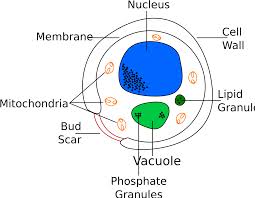Yeasts are living micro -organisms, single-celled fungi, in contrast to molds, which are multicellular.
 Yeasts are found in nature in environments with fermentable sugar -rich fluids, as in the nectar of flowers, on fruit and leaves. Yeasts can cause spoilage of food. However, they are also used in the preparation of certain foodstuffs, such as bread, beer, wine, vinegar, cheese.
Yeasts are found in nature in environments with fermentable sugar -rich fluids, as in the nectar of flowers, on fruit and leaves. Yeasts can cause spoilage of food. However, they are also used in the preparation of certain foodstuffs, such as bread, beer, wine, vinegar, cheese.
The temperature requirements for the growth of yeasts is (the same as that of the fungi) 25-30°C (optimal 33°C) to a maximum of 35-47°C and a minimum at 0°C and less.
Baking yeast (Saccharomyces cerevisiae) is a unicellular fungus that reproduces by budding. The button splits off from the mother in order to become a full-fledged yeast cell itself. It must be kept refrigerated to minimize dehydration. Baker's yeast can grow through until no dough is left, but only a massive lump of yeast.
Yeast can live with or without oxygen. If oxygen and nutrients are available then yeast goes to multiply by budding. If he does not get oxygen as in bread dough that has no oxygen more after minutes of kneading, the yeast will switch to an anaerobic life: he deceives the sugars and turns them into CO2 (carbon dioxide gas bubbles) and alcohol (or ethanol, which rapidly evaporates during baking).
There are many types of yeast of the genus Saccharomyces. Not all have the same ability to ferment the same sugars. For bread we need a yeast that can convert glucose and fructose into CO2 and alcohol.
All (more than 40,000) yeasts belong to one species. According to flavors are different strains used for beer, wine or bread. Tests show that baker's yeast in winemaking during fermentation gives more foam and a cloudier view. But the end result showed equally good. The taste is different, but that is true for wine yeasts themselves also. There are for sale in all possible temperatures, species, etc.
Beer yeasts are selected for fermenting wort. They should also convert maltose in the absence of atmospheric oxygen.
A pure culture is a pure breed of a species of microorganism, in which all the yeast cells or bacteria originate from a single one. The on a suitable medium inoculated culture consists of individuals that are genetically identical, so clones.
